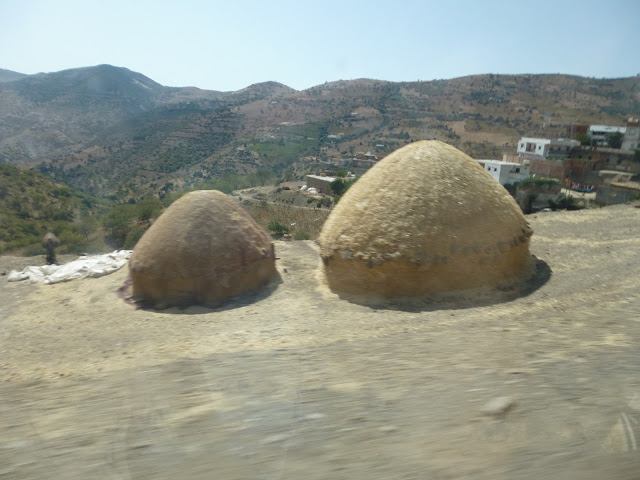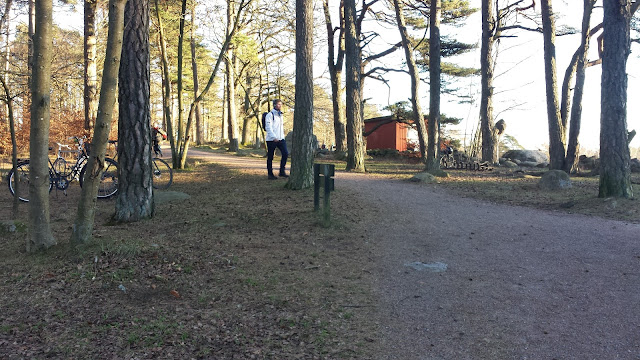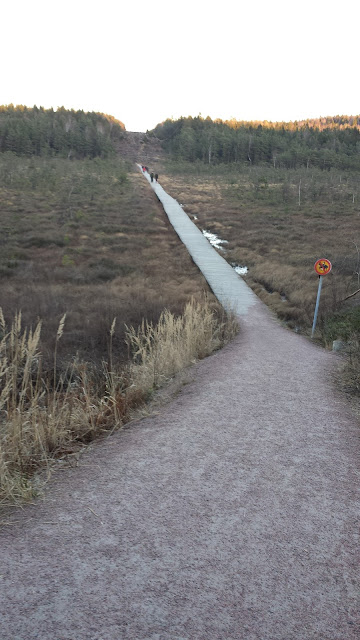Thursday, 2 June 2016
A walk around Stora Delsjön, Gothenburg - January 2015
Today I'll do something a little bit different and instead of the usual story-telling with relatively fewer pictures, I'll just post a lot of photos from a walk I had around the Swedish lake Stora Delsjön, located in eastern Gothenburg. Also I have a few very short video clips from that walk, which I posted here.
Tuesday, 31 May 2016
Travels through Morocco, Part 2 - The Rif Mountains
That day we departed around 11 o'clock and the next 7 hours were spent travelling with a car through the Rif Mountains in the northern parts of Morocco. The mountain range stretches from the Atlantic Ocean to Algeria and we crossed about half of the distance or roughly 350 km. Our goal was to reach Bni Bouayach, small village 15 km south of the bay of Hoceima and in the middle of the distance between Gibraltar and the Algerian border. The road in the beginning was pretty good even according the West European standards, but when we approached the higher and more mountainous parts it turned in the typical hole-ridden third world country-side roads that if not careful can break your car or even kill you. Getting out of Tangier and driving further away gave me the feeling I am leaving a western town and entering some proverbial poor country. Along the road can be seen many small villages, which look rather ghettos. Between the hastily and poorly built houses and barracks can be seen also here and there buildings that I'd call "mini-palaces". However later along the road in the less densely populated areas the landscape changed and was much more rustic and idyllic. The houses were very neat and well spaced with several hundred metres between each other and surrounded with well kept and cultivated farm land. The general rule was that in the centres of the villages were built few small blocks of flats with low quality and the further you get out the better looking and farm-like were the buildings.
Even more strange and impressive was the sight of people walking along the roads, in temperatures exceeding 45C and often 20-30 km from the closest human settlement. After offering to some of them a lift and they refused it, we learned that some of these people are locals who are going after their own jobs and tasks, but the majority were just homeless poor people, who were wandering aimlessly around the mountains. Normally they were wearing thick dirty clothes (or rather rags) and matching shoes. Also most of them had bindle-stiffs and tied big plastic bottles full with water. The only thing I couldn't find was why all of them walked under the Sun in midday, during the hottest hours, but seems it was not troubling them, or at least not enough to make them look for cover.
Talking about the heat, I have to mention that in the Rif Mountains one can often see men and women wearing the traditional Berber clothes, which superficially look like something designed for the cold of the winter and snow, but the protection from heath requires somewhat similar techniques and the final result is somewhat surprising. These costumes are composed of long hanging below the knees (or the ankle for women) light shirt, similar to these worn by the Arabs and aselham, long robe or coat-like garment with pointy hood, which is normally closed in front and is made from relatively thick and coarse material in drab colours. For work in the open normally people wear knit cap or scarf and on top of it the traditional broad-brim Berber straw hats, called "taraza" and specially in the case of the women's ones often decorated with colourful pompoms. And as an conclusion now I am convinced that all this covers, hijabs, etc are rather due to the climate then some other cultural reason, because its not only the women, but also men who are completely covered as protection from the insane heath and burning sun rays. So, below you can see some of the pictures i took from this travel through the Rif Mountains, enjoy!
 |
| Getting out of Tangier |
 |
| Small side roads, leading to farms around Tangier |
 |
| Woman in traditional Berber costume and decorated taraza hat selling prickle pears on side of the road |
 |
| The prickle pears (Opuntia ficus-indica) are in fact cactus fruits and are often sold 1-2 for 1 dirham and peeling them is included in the price |
 |
| I've got to try them in Morocco and they are nothing like these we are getting in Europe. Here are sold much bigger and sweeter fruits. |
 |
| Typical houses in the centres of the small villages along the road in the Rif Mountains |
 |
| View of the fields in the Rif Mountains |
 |
| Another view of the fields |
 |
| Farm land in Rif |
 |
| Groups of conifer trees, some of them are endemic for the region |
 |
| Rock formations in the Rif Mountains |
 |
| Village in the Rif Mountain |
 |
| Oak tree along the road. Some of the oak species are also typical for the region |
 |
| Well watered fields in the Rif Mountain |
 |
| Farmlands in Rif |
 |
| Fields in Rif |
 |
| Farms along the roads |
 |
| Village in Rif |
 |
| There were a lot of people wearing traditional Berber clothes |
 |
| Stalls along the main roads |
 |
| Often can be seen these strange restaurant/BBQ places were you can bring your own meat to be roasted |
 |
| These old Mercedes used often as taxis are another typical view for the country |
 |
| Man with the Berber hooded robe, called "aselham" |
 |
| A lot of tea houses can be seen everywhere and there are always a people in them |
 |
| Typical view from a car window when passing village in the Rif Mountain |
 |
| Another group of conifers |
 |
| Single tree |
 |
| Park in a village along the road through Rif |
 |
| Valleys and scenic landscapes in the Rif Mountains |
 |
| The higher parts of the Rif range |
 |
| View from the road in the higher parts of the mountain |
 |
| Typical haystacks along the road in Rif |
 |
| Landscape - Rif |
 |
| Roadhouse and grocery in the Rif Mountain |
 |
| View of the road in Rif |
 |
| Often can be seen children running around the road and selling stuff to the drivers, sometimes many miles from the closest settlement |
Walk in the Garden of the Turia, January 2007 - Short clips
This video is collection of several short clips which I took while having a walk in the Garden of the Turia, January 2007. This was the very first time I used video recorder and while the quality is not great when looked in 2016, for that time it was one of the more expensive video cameras.
This video has rather "historical" then modern day entertaining value and shows what it was then, shortly after that part of the park was completed
Monday, 30 May 2016
Healthy lifestyle basic concepts - avoiding monotony and repetition
In this video I talk about some basic concepts, which are part of more natural way of living. In short the idea is that it was unlikely that our ancestors had 3 square meals a day and they rather ate and exercised in unpredictable and chaotic way. So, to emulate as close as possible that lifestyle, for which we evolved, we should try to avoid repetition and routine.
Also the primitive human never knew when will come next meal (if it comes at all that day), what is going to be and what physical activity will be required to get it. In the same spirit we should try to surprise more often our bodies with the food we eat and exercises we do.
Below follows excerpt from the video:
"In this video I'll be talking about the rigidity of the life styles we'd like to maintain. First my core idea of whatever I do is to avoid the monotony and repetition. In the case of exercising for example I'll have one day one or two hours jogging, another day will be simply a long walk. Next day will be lifting weights in the gym. Another day will be wrestling, kick-boxing and so on. The general idea is to avoid repetition at any cost, because we are not designed and our body waste quite fast if we begin repeating the same physical motion again and again.
Same goes for the food. Despite having few core components, like meat, fruits, vegetables and nuts, what I'm trying to do is to avoid repeating the exact type of food that I'm eating. For example one day it could be meat, another day it could be fish. I recently tried elk meat, which was very tender and with much better taste then the cooked version. The berries that I normally eat can be swapped with grapes, apples, mango, orange, kiwi etc.
Also normally I eat some kind of onion. This could be swapped with garlic. Sometimes I eat row eggs but I try to eat as diverse as possible types of eggs. For example instead of the normal chicken egg I eat quail eggs. Also there are many, many types of nuts which all have different properties and different chemical components. I have hazelnuts, almonds, pecan nuts and so on, and so on.
Avoiding the monotony and trying to make my life style as diverse as possible goes up to the point that once a week for example is OK to completely skip the paleo food and eat just cheeseburgers or other very unhealthy food which essentially can't do any damage and likely will be beneficial if eaten rarely.
Another thing that I'm doing is sometimes maybe once a week or once biweekly I'm having one day when I'm skipping eating at all. This is not at all harmful and after a while we you can get used to it and it could gives you boost of energy the next day.
Another important thing is that the amount of food that we eat to be according to the energy spent. Despite of eating healthy food if we keep overeating we can get very obese and exercise is not going to help us as we can see in the case of sumo wrestlers.
The other site of the spectrum we can see people who eat very healthy but don't exercise at all. They have the kind of the aspect of dead fish. Humans have to maintain a certain level of physical activity a day and certain level of energy consumed in the form of food eaten."
Subscribe to:
Posts (Atom)










































































































